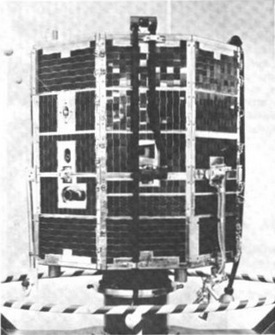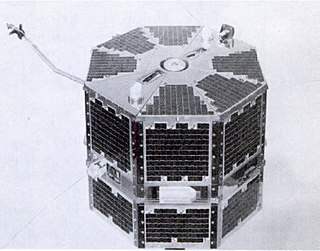
Orbiting Vehicle or OV, originally designated SATAR, comprised five disparate series of standardized American satellites operated by the US Air Force, launched between 1965 and 1971. Forty seven satellites were built, of which forty three were launched and thirty seven reached orbit. With the exception of the OV3 series and OV4-3, they were launched as secondary payloads, using excess space on other missions. This resulted in extremely low launch costs and short proposal-to-orbit times. Typically, OV satellites carried scientific and/or technological experiments, 184 being successfully orbited through the lifespan of the program.

Orbiting Vehicle 1-1, was the first satellite in the OV1 series of the United States Air Force's Orbiting Vehicle program. OV1-1 was an American Earth science research satellite designed to measure radiation, micrometeoroid density, and magnetic fields in orbit. Launched 21 January 1965, the mission resulted in failure when, after a successful launch of its Atlas booster, OV1-1's onboard Altair motor failed to fire.

Orbiting Vehicle 1-2, launched 5 October 1965, was the third, and first successful, satellite in the OV1 series of the United States Air Force's Orbiting Vehicle program. A radiation measuring satellite designed to conduct research for the planned Manned Orbital Laboratory project, OV1-2 was the first American spacecraft to be placed into orbit on a western trajectory. The satellite stopped functioning in April 1967 after a series of technical problems starting two months after launch.

Orbiting Vehicle 1-5 was launched 30 Mar 1966, and was the fifth satellite in the OV1 series of the United States Air Force's Orbiting Vehicle program. OV1-5 conducted optical experiments, surveying the Earth in the infrared spectrum to see if water, land, mountains and deserts could be distinguished by their thermal gradients. It was launched concurrently with OV1-4 in the first ever side-by-side satellite orbital deployment.

Orbiting Vehicle 3-4, launched 10 June 1966, was the second satellite to be launched in the OV3 series of the United States Air Force's Orbiting Vehicle program. The satellite measured radiation above the Earth, helping to determine the hazard posed to human spaceflight at typically traveled altitudes. OV3-4 is still in orbit as of 6 June 2021.

Orbiting Vehicle 2-5, the third and last satellite of the second series of the United States Air Force's Orbiting Vehicle program, was an American particle science and ionosphere research satellite. Launched 26 September 1968 along with three other satellites, OV2-5 became the first scientific satellite to operate at geosynchronous altitude.

Orbiting Vehicle 1-7, launched 14 July 1966, was the sixth satellite launched in the OV1 series of the United States Air Force's Orbiting Vehicle program. OV1-7 was a sky science satellite, designed to return data on charged particles in orbit as well as measurements of solar X-rays and nightglow. Co-launched with OV1-8, the satellite was lost when it failed to detach from its launch rocket.

Orbiting Vehicle 1-8, launched 14 July 1966, was the seventh satellite launched in the OV1 series of the United States Air Force's Orbiting Vehicle program. OV1-8 was designed to test the passive communications utility of an aluminum grid sphere versus a balloon satellite.

Orbiting Vehicle 3-3, launched 4 August 1966, was the third satellite to be launched in the OV3 series of the United States Air Force's Orbiting Vehicle program. The satellite measured charged particles in orbit so that their danger to space-based payloads could be assessed. OV3-3 is still in orbit as of 29 July 2021.

Orbiting Vehicle 3-2, launched 28 October 1966, was the fourth satellite to be launched in the OV3 series of the United States Air Force's Orbiting Vehicle program. The satellite measured charged particles in orbit, mapping irregularities in the ionosphere, particularly the auroral zone. OV3-2 reentered the Earth's atmosphere on 29 September 1971.

The Environmental Research Satellite program was a series of small satellites initially operated by the United States Air Force Office of Aerospace Research. Designed to be launched "piggyback" to other satellites during launch, detaching once in orbit, they were the smallest satellites launched to date—what would today be classified as microsatellites. 33 ERS satellites in six different series were launched between 1962 and 1971, conducting scientific research and serving as test beds to investigate the reliability of new spacecraft components.

Orbiting Vehicle 1-9, launched 11 December 1966 along with OV1-10, was the ninth satellite in the OV1 series of the United States Air Force's Orbiting Vehicle program. OV1-9 recorded low frequency radio emissions and particle radiation in Earth's exosphere; the satellite also collected data on the impact of long-term radiation on biological samples and tissue equivalents. OV1-9 returned the first proof that Earth has an electric field.

Orbiting Vehicle 1-10, launched 11 December 1966 along with OV1-9, was the tenth satellite in the OV1 series of the United States Air Force's Orbiting Vehicle program. Designed to observe atmospheric airglow, X-ray and cosmic radiation, OV1-10 returned significant data on the Sun as well as on geophysical phenomena in Earth's magnetic field. OV1-10 reentered Earth's atmosphere on 30 November 2002.

Orbiting Vehicle 3-5, launched 31 January 1967, was the fifth satellite to be launched in the OV3 series of the United States Air Force's Orbiting Vehicle program.

Orbiting Vehicle 1-11 was an American satellite launched 27 July 1967 to study a range of environmental conditions in the upper atmosphere. Part of the OV1 series of USAF satellites, using standardized designs and sent to orbit on decommissioned Atlas ICBMs to reduce development and launching costs, OV1-12 was launched with two other satellites in the series, OV1-12 and OV1-86, in the first triple launch of the program. The satellite was lost during launch when its onboard propulsion module failed.

Orbiting Vehicle 1–12 was a satellite launched 27 July 1967 to measure the radiation hazard posed by solar flares. Part of the OV1 series of USAF satellites, using standardized designs and sent to orbit on decommissioned Atlas ICBMs to reduce development and launching costs, OV1-12 was launched with two other satellites in the series, OV1-11 and OV1-86, in the first triple launch of the program. Only partially successful due to an inability to remain stable in orbit, the satellite reentered the Earth's atmosphere on 22 July 1980.

Orbiting Vehicle 3-6, launched 5 December 1967, was the sixth and last satellite to be launched in the OV3 series of the United States Air Force's Orbiting Vehicle program. The satellite measured electron density and neutral density ion composition, as functions of latitude and time. The satellite reentered the Earth's atmosphere on 9 March 1969.

Orbiting Vehicle 5-3, was a materials science microsatellite launched on 28 April 1967 and still in orbit as of 2020. Carrying a variety of metal and plastic samples, it conducted friction tests on them in the vacuum of space to help determine their usability in space equipment. OV5-3 was the second satellite in the OV5 series of the United States Air Force's Orbiting Vehicle program.

Orbiting Vehicle 1–13 was a satellite launched on 6 April 1968 to measure the level of radiation in orbit at altitudes as high as 8,000 km (5,000 mi). Part of the OV1 series of USAF satellites, using standardized designs and sent to orbit on decommissioned Atlas ICBMs to reduce development and launching costs, OV1-13 was launched side-by-side with OV1-14. The launch marked the first usage of the Atlas F in the OV program. Operating for more than a year and a half, OV1-13 mapped the grosser characteristics of the Van Allen radiation belts and contributed to the understanding of how particles flow and cause increased intensities during solar storms. As of 12 May 2023, OV1-13 is still in orbit.

Orbiting Vehicle 5-8, was a materials science microsatellite launched, along with 12 other satellites in the biggest multi-satellite launch to date, on 18 August 1968 on the first Atlas Burner 2 rocket. The rocket and all payloads were lost when the second stage (Burner) shroud collapsed after first stage (Atlas) cutoff. OV5-8 was the third satellite in the OV5 series of the United States Air Force's Orbiting Vehicle program.














